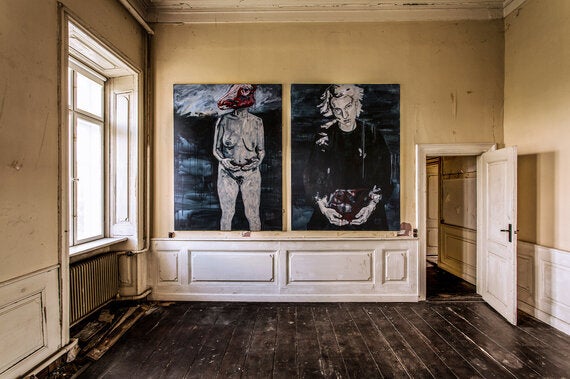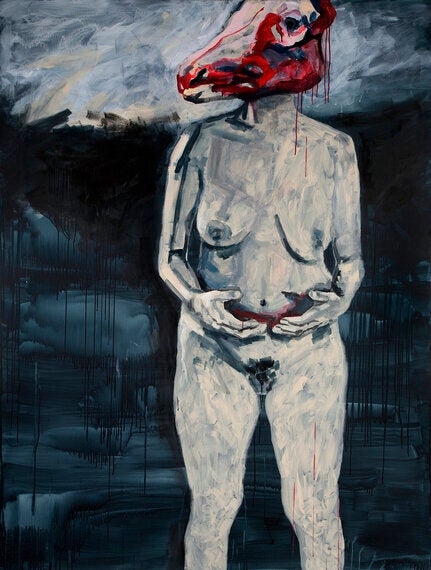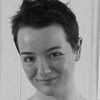
Bolatta Silis-Høegh was born in Qaqortoq, Greenland in 1981, and now bases her practice in Copenhagen, Denmark. I encountered Silis-Høegh's exhibition Lights On Lights Off in Nuuk Kunstmuseum last August. Many people in the Greenlandic capital were wearing badges stating their opposition to uranium mining that summer; Silis-Høegh's dark and visceral paintings carried the protest to another level.
Your self-portraits 'Inside' and 'Outside' were recently acquired by the National Museum of Greenland. In these two works your body is depicted as both proudly naked but also suffering, your eyes confronting the viewer with an angry and direct gaze. How does this raw imagery relate to your political concerns?
It was a physical reaction. When the uranium ban was cancelled I stayed for two days in bed with headaches and fatigue. I had never reacted to political decisions this way before. I was so angry, disappointed and shameful. And very scared for the future. Not knowing what we are getting into and having a sense that we didn't really know what it meant, because we hadn't talked about it.
I wanted to scream at the silence, and I did.
I couldn't put my uranium anger into words, but painting it out opened up other hidden memories that I had long forgotten. Greenland has some of the highest rates of violence, abuse and suicides and by not discussing our problems openly I see it as kind of society's acceptance of the monstrous, and now we were going to do the same to our nature.
Long away from home, it was easier for me to scratch black paintings and a naked, bloody me. You might not see a direct protest to the political concerns, but more an emotional landscape awakening from my protest.

When I spoke to Nivi Christensen, Director of Nuuk Kunstmuseum, about Lights On Lights Off, she told me that you worked intensely on these painting over a short period of time. Was this a new approach for you?
After two days in bed, a sudden powerful urge to paint came to me.
I grabbed the emotions, and painted them out real fast. I felt very close to the canvas, and hopefully that intimacy is there in the paintings. It killed off the pretty me. Each finished painting was a therapeutic relief, and I had a bit of a shock after an intensive two months when my studio suddenly was packed with dark images. I thought, "Wow, I must really love this country, since I can react so strongly." A love for my home country but without the romance.
Your earlier works such as Haveforeningen Sisimiut 2068, a witty installation that depicts Greenland as a semi-tropical landscape, are very different in tone and even in the media they use...
During COP15 in Copenhagen I created a future garden in Greenland, showing Greenlandic symbols and tools adapted in the lush tropical setting. I used humour to address important issues such as climate change in this installation. In my recent exhibitions I felt a need to get rid of that filter, and suddenly I had no need for colours and irony. All I wanted was to express what was on my mind. It was also a relief to paint again. I had spent years striving for a European conceptual art look, and it was great to find out that I am a painter, and that I am most honest in this media.
Coming from a family of artists, you must have been very aware of visual culture in Greenland as you were growing up.
Going to exhibitions with my mother [painter Aka Høegh], I responded to paintings. Paintings of nature with soul, and the chilly, foggy mornings where you can really breathe. I still like that.
In Greenland we tell a lot of image-making stories, we especially love ghosts or scary stories - traces of this kind of imagery might occur in my works. I've definitely inherited the respect for nature, guided by so many myths and legends. Being in Greenland you do feel the powers of nature, and I want to show that.
Not to forget my Latvian side. My father [photographer Ivars Silis] escaped from Latvia during the Second World War when he was four. I haven't been so attached to Latvia growing up far away from the country, but last year when I had an exhibition there someone told me, "You have a Latvian pencil stroke but with arctic colours." Everything is somehow connected.
Details
Find out more about Bolatta Silis-Høegh's work on her website. Her exhibition S T O R M is at the Cultural House in Sisimiut, Greenland, until 22 May 2016.
